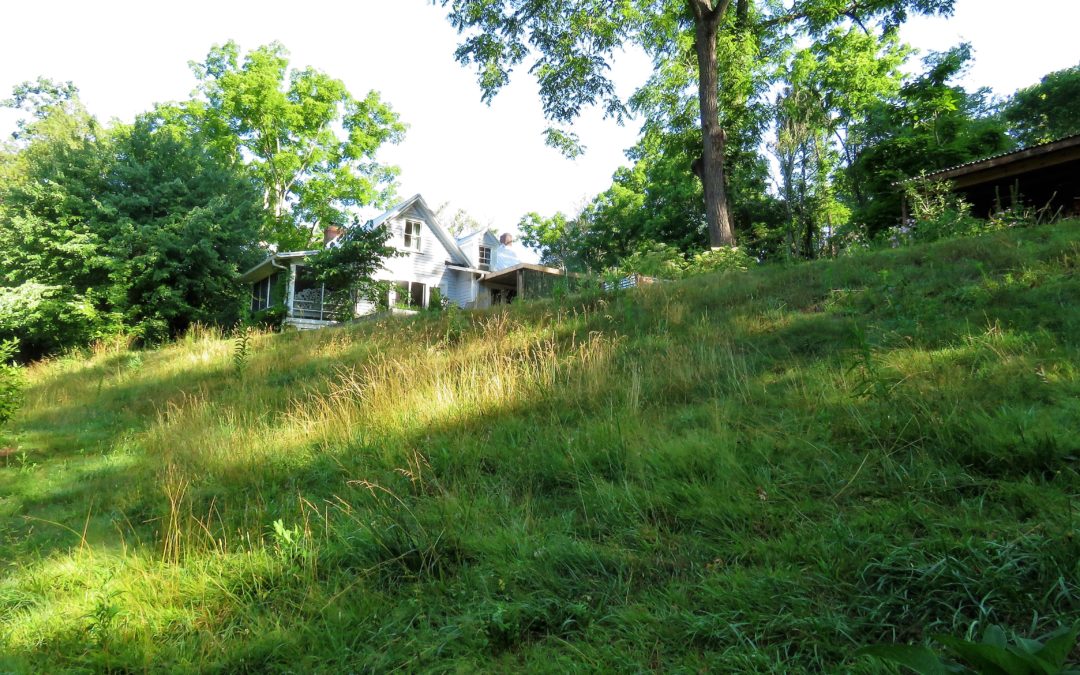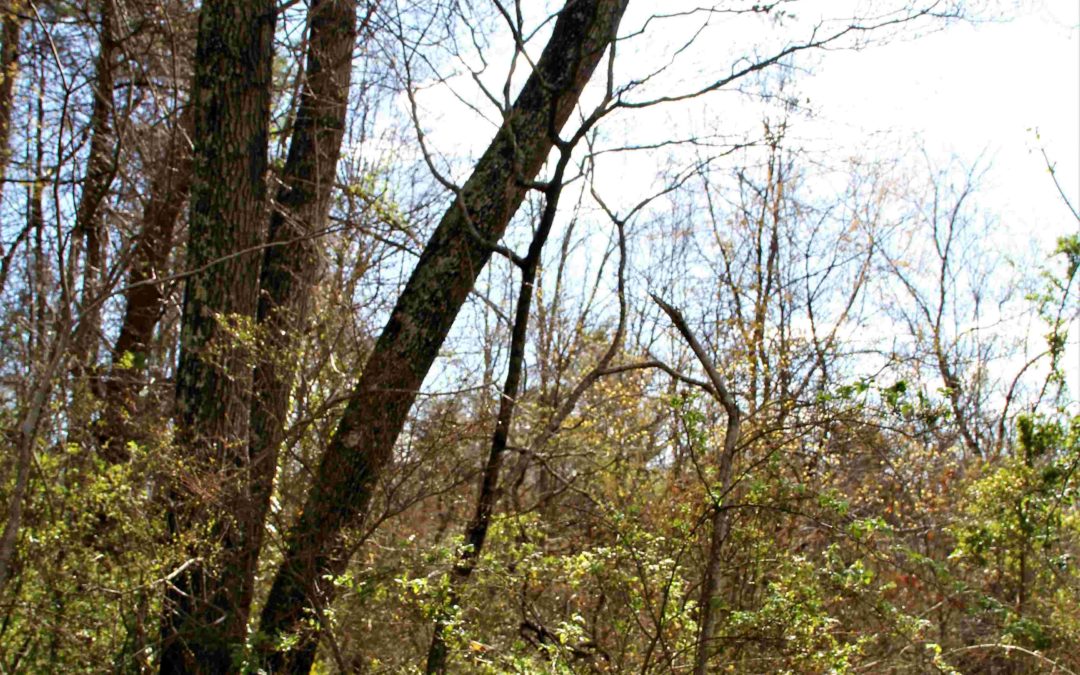
100 Days – Rewilding Land and Self
Tuesday marked 100 days of rewilding. For the past six weeks or so, writing duties nagged at the back of my mind – I should be writing a blog post and working on dissertation research – but the draw of the outdoors proved irresistible. As the world started to awaken and burst forth at Beltane with the exuberance of late spring, a primal urge to dig in dirt, plant seeds, and generally spend most waking hours outside overtook all my best scholarly intentions. I wonder if my rewilding psyche, withdrawing from an unhealthy addiction to electronic stimulus and other continuous distractions, now yearns to align more naturally with seasonal cycles. The Birds and Squirrels reported that late spring and early summer demand time for doing. Spending each day within the flesh of my body’s physicality, as I worked with more-than-human co-researchers to rewild the Land, felt like an imperative, not to be ignored. So, I went with it. As the wheel of the year turns again, and we enter the long, warm days past the Summer Solstice, the heat of midday once again drives me indoors. The computer and the research now seem approachable. The weeds, unlike the planting of seeds, can wait. Urgency fades, and I find myself moving again towards writing. Where to begin?
Changes occur within and without. A view of branches and sky, once filled with only the anticipation of budding trees, now dazzles with leafy green ebullience. Left to their own devices, the Land wildly designs, with a broad palette of both desirable and undesirable species (from a human perspective). In addition to the Goldenrod Solidago spp., Evening Primrose Oenothera biennis, Daisy Chrysanthemum leucanthemum, Joe Pye Eupatorium fistulosum, and other native Plants; non-natives, such as Tree of Heaven (ToH) Ailanthus altissima (or Hell, as I have come to think of it) and Asian Bittersweet Celastrus orbiculatus, threaten to entirely subsume some areas.
Bittersweet strangles and kills the hosts it twines itself around, and ToH is allelopathic, killing competing plants via chemical weapons produced in leaves and roots. If I recognize the agency of Bittersweet and ToH, and their right to exist, then how can I justify killing them? I have decided to subscribe to both the North American Indigenous imperative to honor all beings (Benton-Banai, 1988) and to Aldo Leopold’s axiology that determines an action to be ethical when it supports, protects, and enhances the natural world (including humans) (Leopold, 1949). At a recent basket weaving workshop at the Firefly Gathering, taught by Nancy Basket (a Cherokee elder), she expressed the view that all Plants (and all beings) have a purpose. She urged us to rethink our definitions and preconceptions of “invasive” species and view them instead as abundant producers, just begging to be put to work. Our lives depend on deaths of others, be they Plants or Animals, every day, but those deaths can be purposeful and honored (Kimmerer, 2013). Bittersweet seems to lend themself nicely to weaving of all kinds. I am still trying to discover how ToH can be useful.
The Critter population also booms. The former lawn, now a promising Meadow, reaches waist-high and shelters families of Rabbits, Turkeys, and Groundhogs. Indigo Bunting, Brown Thrasher and Flicker, all newcomers to the Land, also join the fray. The Tomatoes and Three Sisters (that haven’t been decimated by Groundhogs) set fruit, bean, and cob, promising an abundant harvest soon, and the permaculture guilds I developed along borders (with significant help from friend and worker extraordinaire Kimberly) establish themselves and settle into their new, permanent, perennial homes.
I am changing too. After two years of living encumbered by long covid, my body now remembers its strength, agility, and overall sense of well-being. I have lost 13 pounds (without trying to do so), and my doctor says she wishes all her patients had my blood pressure and blood sugar levels. Psychologically, however, the baseline resists change. Despite feeling less anxious, I find my usual neuroses and triggers persist. To ripen into my full wildness, I must also recover and embrace the aspects of my psyche living in the shadows of the dominant worldview and dissociated via childhood traumas and cultural programming. Bill Plotkin (2013) says that in order to heal the planet, humans must first heal themselves. Therefore, in the interest of being fully available for the work that calls me in the world, I decided to take the plunge into the hidden psychological wilderness of my unconscious mind, and with the arrival of the Super Flower Blood Moon, I brewed myself a strong decoction of Mugwort Artemisia vulgaris, an Herb known to stimulate powerful and lucid dreams, and fell asleep under the eclipsed Moon.
My partner of 34 years, Simon, and I are looking for a house to live in. I want to build a secluded place in the Woods, but he informs me that he has already agreed to buy a house in a neighborhood with a group of friends. The neighborhood, Leeward, in the Turks and Caicos Islands, is a trendy location for an elite few. I cringe at the thought but nevertheless agree to give it a go.
The house borders the Ocean, and when I step outside, I discover the Sea lapping at the house’s foundation. I say to Simon, “We can’t live here! If it looks like this on a calm day, what is going to happen with global Sea rise or a Tropical Cyclone?” Fortunately, he agrees with me, and we inform our friend that we cannot go through with the deal. Our friend (who is not this way in real life) furiously starts lambasting me, accusing me of spreading deliberately alarming climate change “conspiracy” theories and telling Simon how stupid he is to listen to me and miss out on such an excellent investment opportunity. Persuading our friend of the risk inherent in building homes on the Ocean’s doorstep is futile. His financial projections outweigh any climate reality.
Simon and I find another place to stay temporarily in a communal home shared with several other people. While I am unloading my few belongings into a closet, Cindy Crawford (supermodel) appears wearing nothing but a diaper. She says, “I thought I heard someone down here, so I just threw on the first thing I could find.”
I went to sleep with the mysteries of the hidden world on my mind and upon awaking, initially interpreted my dream as a revelation about how Western culture relegates environmental truths and ecological imperatives to the shadows, focusing instead on profit margins and investment opportunities while the world burns, forests are razed, and a rising ocean threatens to subsume us. Cindy Crawford, a symbolic pinnacle of the culture’s fascination with superficial appearances, wears a diaper, suggestively covering her root and sacral chakras, representing early childhood and adolescent development and rootedness and belonging, respectively. The world’s major religions and myriad Indigenous cultures teach that practicing reciprocity, kindness, and generosity represents the pinnacle of human spiritual development. In contrast, Western culture rewards taking and hoarding of “resources,” selfishness, and “looking out for number one,” immature impulses arising from feelings of insecurity (root chakra) and fractured notions of belonging (sacral chakra).
I thought my dream reflected the shadows of the dominant culture; however, being aware that dreams more often than not reveal truths from within oneself (Plotkin, 2013; Zadra & Stickgold, 2021), I committed to keeping my mind open to other possibilities. A few weeks later, on the Summer Solstice, I was outside offering water to some Plant co-researchers and ran into my human neighbor who was also watering. “What are you growing?” I asked. “Nandina” (Nandina domestica – an invasive ornamental floral species that is toxic to Birds) she replied. “While I have you here,” she added, “I was wondering if I could cut down that Virginia Creeper (Parthenocissus quinquefolia) in your yard. It’s spreading all over my property.” After explaining Virginia Creeper’s native status and usefulness to Wildlife, including Birds, Opossums, and Racoons, I said “sure” and then proceeding to tell her how to do it, thereby violating every tenet of my rewilding project. Later, an irate Bumblebee Bombus spp. accosted me and stung me three times. I didn’t even know Bumblebees could sting, given their typical docile nature.
As I went inside to nurse my stings and sit with my own confusing behavior, I had a revelation. Although my neighbor, with her Virginia Creeper-free lawn and non-native, Bird-killing flora, could be accused of subscribing to ecologically unsound cultural landscaping norms, I crumbled at the first human challenge to the rewilding project. Although I think of myself as an independent outsider, Virginia Creeper and Bumblebee showed me that deep within my psychic shadows, my unconscious insecurity and need for tribal acceptance can overrule even my most strongly held values. I wrote my neighbor a note and told her I had changed my mind. My more-than-human co-researchers showed me the path of humility. Despite my self-aggrandizing feelings (courtesy of a privileged elite education) of ecological superiority, I need to start from the root – the most basic, infantile, and utterly human parts of myself – and work my way towards wildness from there. I am an experienced and knowledgeable environmental scientist and compassionate rewilder, but I am Cindy Crawford in a diaper too.
References
References
Benton-Banai, E. (1988). The Mishomis Book: The voice of the Ojibway: University of Minnesota Press.
Kimmerer, R. (2013). Braiding Sweetgrass: Milkweed Editions.
Leopold, A. (1949). A Sand County Almanac and Sketches Here and There: Oxford University Press.
Plotkin, B. (2013). Wild Mind: A field guide to the human psyche: New World Library.
Zadra, A., & Stickgold, R. (2021). When Brains Dream: Exploring the science and mystery of sleep: Norton.
